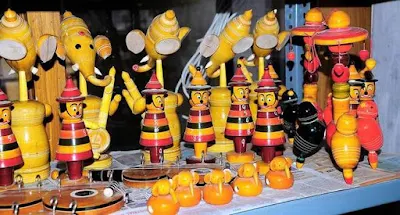Geographical Indication Registry has given the Geographical Indication (GI) tag to the traditional Etikoppaka toys made by the artisans in the village.


- The art is more than 400 years old which has been traditionally handed over to them by their ancestors through generations.
- The toys are unique in shape and form and the material used is made of wood and painted with natural dyes.
- The wood used to make these toys is obtained from ‘Ankudi Karra’ (Wrightia tinctoria) tree.
- The wood is soft in nature and the art is also known as turned wood Lacquer craft.
- The Etikoppaka toys now join the elite products from Andhra Pradesh such as Kondapalli toys, Bobbili Veena, Tirupati laddu, Srikalahasthi Kalamkari, Uppada Jamdani sarees and Shadow puppets.
What is GI Tag?
- The GI is a name or sign used on certain products which relate to a specific geographical location or origin.
- As per the regulations, goods and products having the tag are recognised for their origin, quality and reputation
- India, as a member of the World Trade Organization (WTO), enacted the Geographical Indications of Goods (Registration and Protection) Act, 1999 has come into force with effect from 15 September 2003.
- GIs have been defined under Article 22(1) of the WTO Agreement on Trade-Related Aspects of Intellectual Property Rights(TRIPS) Agreement as: "Indications which identify a good as originating in the territory of a member, or a region or a locality in that territory, where a given quality, reputation or characteristic of the good is essentially attributable to its geographic origin.
- The GI tag ensures that none other than those registered as an authorised user are allowed to use the popular product name.
- Darjeeling tea became the first GI tagged product in India, in 2004-05, since then by May 2017, 295 had been added to the list.


